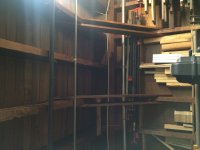I’m doing some basic seismic retrofitting, insulating, and drywalling of our garage located under our home, which is also my shop. The home is late 1930s. Since all the framing is currently exposed, I’m taking the opportunity to also stiffen the bouncy floor above, and modify framing to shore up weak spots...eg repair herringbone struts.
My question concerns some existing framing that I don’t know the term for but have always wondered about. These are 45 degree supports made from 1x6 that connect floor joists above to wall studs below. Originally they were located on every other joist/stud, but one side of the house has seen most of them cut/removed over the decades I assume for plumbing/electrical projects. What exactly is the function of these supports and how effective are they? I assume they partly support the joists somewhat reducing the effective span, and also prevent twisting of the joist? Since they take up a decent amount of headroom and also present drywall challenges, I’m wondering about removing them, but replacing their “function” with the appropriate measures. Thoughts?
My question concerns some existing framing that I don’t know the term for but have always wondered about. These are 45 degree supports made from 1x6 that connect floor joists above to wall studs below. Originally they were located on every other joist/stud, but one side of the house has seen most of them cut/removed over the decades I assume for plumbing/electrical projects. What exactly is the function of these supports and how effective are they? I assume they partly support the joists somewhat reducing the effective span, and also prevent twisting of the joist? Since they take up a decent amount of headroom and also present drywall challenges, I’m wondering about removing them, but replacing their “function” with the appropriate measures. Thoughts?

